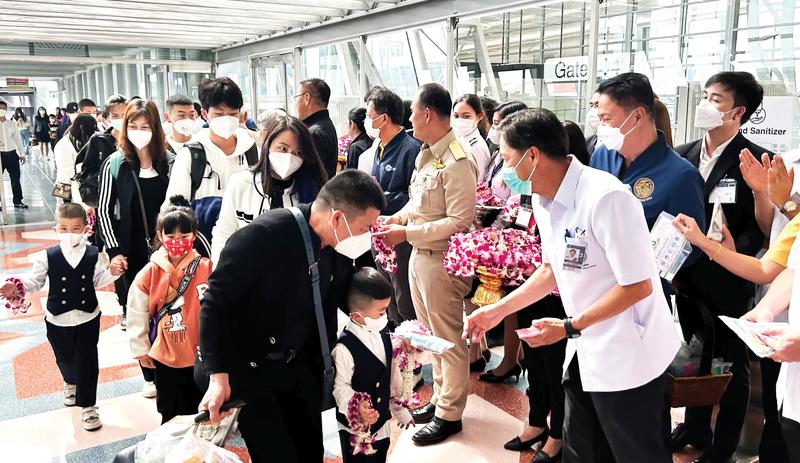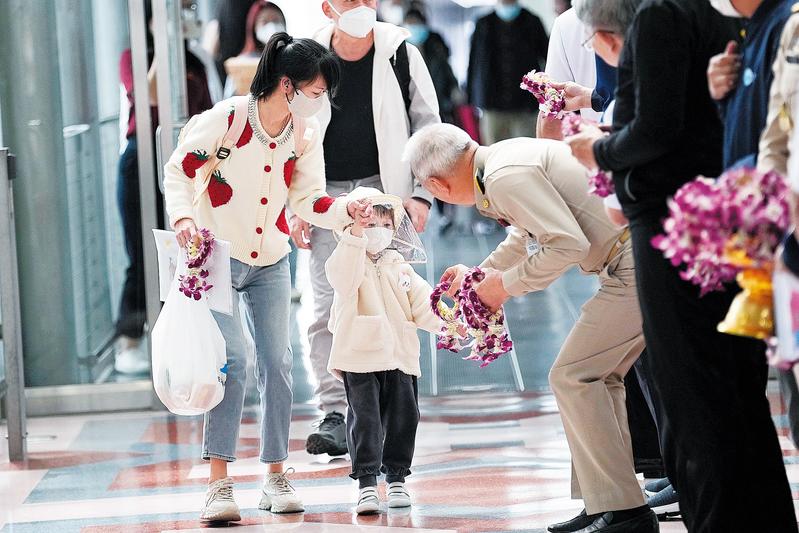Thailand, Cambodia and Indonesia among the nations hoping for large visitor influx as Beijing relaxes curbs
 Thares Krasanairawiwong, director-general of the Disease Control Department with Thailand’s Ministry of Public Health, presents gifts to a Chinese boy and his father upon their arrival at Bangkok’s Suvarnabhumi Airport on Jan 9. (YANG WANLI / CHINA DAILY)
Thares Krasanairawiwong, director-general of the Disease Control Department with Thailand’s Ministry of Public Health, presents gifts to a Chinese boy and his father upon their arrival at Bangkok’s Suvarnabhumi Airport on Jan 9. (YANG WANLI / CHINA DAILY)
Southeast Asian nations are rolling out the welcome mat for Chinese tourists as Beijing eased the restrictions on cross-border travel in optimized pandemic response policies.
Observers believe Chinese visitors will help revive the COVID-battered tourism-related businesses, shoring up the economies in the wider region.
On Jan 9, Thailand welcomed its first group of Chinese tourists after updating its arrival policy on Jan 7, with local authorities fully opening their arms to inbound travelers by removing the requirement of vaccination before entry.
Anutin Charnvirakul, Thailand’s deputy prime minister and minister of public health, said: “Visitors who are not vaccinated at all will also be granted entry without restriction. Showing proof of vaccination would be cumbersome and inconvenient, so our decision is that it is unnecessary.”
Thailand is also offering visitors a longer period of stay. Effective through March 31, the period of stay is extended from 30 days to 45 for tourists from countries and regions that qualify for visa exemption, and to 30 days instead of 15 for those eligible for a visa on arrival.
The announcement was made after a welcoming ceremony on Jan 9 for the first group of Chinese tourists to arrive at Bangkok Suvarnabhumi Airport since Thailand updated its travel policy.
China optimized its own travel protocol for inbound arrivals from Jan 8.
Xiamen Airlines flight MF833, carrying 269 Chinese tourists, landed in the Thai capital after flying from East China’s Fujian province.
A large group of greeters led by Anutin, the public health minister, Transport Minister Saksayam Chidchob and Tourism and Sports Minister Phiphat Ratchakitprakarn welcomed the tourists after their arrival.
Officials presented the tourists with orchid garlands, souvenirs and leaflets in Chinese. They also held up a banner that read: “Chinese and Thais come from the same family. Amazing Thailand will always warmly welcome Chinese people.”
“That was a big surprise to us. Thailand’s people are very amicable,” said Ma Zixiao, a traveler from Beijing. “It’s exciting that we can come back to Thailand, as we last paid a visit to the country in 2016.”
 Thai Minister of Tourism and Sports Phiphat Ratchakitprakarn presents a garland to a Chinese girl after she lands in Thailand on Jan 9. (Sakchai Lalit / AP)
Thai Minister of Tourism and Sports Phiphat Ratchakitprakarn presents a garland to a Chinese girl after she lands in Thailand on Jan 9. (Sakchai Lalit / AP)
According to statistics from the Tourism Authority of Thailand, Chinese travelers accounted for one-fourth of the total international inbound tourists to Thailand before the COVID-19 pandemic. There were more than 11 million Chinese visitors in 2019 alone, generating over 500 billion baht ($14.95 billion) in tourism revenue.
The number dropped sharply in 2020 and 2021. Last year saw the number of inbound Chinese travelers surge to nearly 290,000.
Following China’s optimization of its COVID control policy, the Tourism Authority of Thailand estimated that the number of international inbound tourists this year is likely to reach 25 million. It believes that starting from Jan 9, about 300,000 Chinese tourists will arrive in the first quarter — 60,000 in January, 90,000 in February and 150,000 in March. A total of 5 million Chinese tourists are expected to visit Thailand in 2023.
Tanes Petsuwan, the Tourism Authority’s deputy governor for international marketing for Asia and the South Pacific, said he was very glad to see an increase in the number of Chinese visiting Thailand. “Most Thai people are very happy. The situation of COVID-19 is under control. Both the number of deaths and new cases are very low,” he said.
Phuket, one of the most popular island destinations among Chinese tourists, now has about 60 percent of its private sector back in business. Bhumikitti Ruktaengam, advisory chairman of the Phuket Tourist Association, told local media that about 20 percent of the island’s suspended businesses could reopen if Chinese tourists return.
In addition to Chinese tourists’ favorite activities of visiting beaches and enjoying the food, “we would like to promote exclusive tour packages in the northeast region, the less-trampled corner of Thailand, which is filled with natural beauty”, said Yuthasak Supasorn, governor of the Tourism Authority of Thailand.
Elsewhere in Southeast Asia, Cambodia is also proactively preparing to welcome back Chinese tourists after China began to gradually resume outbound tourism from Jan 8.
“The whole of Cambodia is waiting for the return of the Chinese tourists and we are ready to welcome them,” said Thourn Sinan, chairman of the Pacific Asia Travel Association Cambodia chapter.
Given the long-time relationship between the two countries, Sinan said he expects not only the return of tourists but also investors.
Cambodia is ready to welcome back visitors from the Chinese mainland, with their numbers estimated to reach one million in 2023, a tenfold increase from 2022, the country’s Tourism Minister Thong Khong said on Jan 6, The Phnom Penh Post reported.
Khong said the government has “clear plans and programs” prepared to cater to Chinese tourists.
This year marks the 65th anniversary of the establishment of diplomatic ties between China and Cambodia, and the Southeast Asian nation will launch a “Cambodia-China Good Friend” campaign to welcome Chinese tourists.
“Cambodia is pleased to welcome Chinese tourists to visit Cambodia without any health conditions,” the tourism ministry said in a statement on the same day.
It said China’s easing of COVID-related travel restrictions will give a big boost to the tourism sector in all countries.
In 2019, more than 2.3 million Chinese tourists visited Cambodia, accounting for 35.7 percent of the total international tourist arrivals in the country and about $1.8 billion of the total tourism revenue of nearly $5 billion, according to the ministry.
In the same year, tourism-related investment from China also accounted for more than half of Cambodia’s total foreign direct investment.
“Chinese investors and tourists importantly contribute to the growth of tourism and the socioeconomic development of Cambodia,” the ministry said.
The statement came after Cambodian Prime Minister Hun Sen said on Jan 2 that the presence of Chinese tourists is vital to the country’s tourism and economic growth and that the country will not follow other nations in imposing any additional COVID-related restrictions on arrivals from the Chinese mainland.
Before the pandemic, China was the world’s most important outbound tourism market. In 2019 alone, Chinese citizens made 155 million trips abroad and spent nearly $255 billion, accounting for almost one-fifth of global tourism spending, according to the United Nations’ World Tourism Organization.
Sinan from the Pacific Asia Travel Association said the Cambodian government is expecting to see a big number of arrivals to Cambodia from China as some countries like Japan have imposed entry restrictions on Chinese citizens.
But Sinan said Cambodia will face competition from other neighboring popular tourism destinations such as Thailand and Vietnam as they, too, have no restrictions on Chinese travelers.
As the Chinese New Year, which falls on Jan 22 this year, is approaching, Chhay Sivlin, president of the Cambodia Association of Travel Agents, said she expects to see a bigger number of Chinese tourists going abroad after the holiday.
Sivlin said Cambodia has what it takes to bring in significant numbers of Chinese visitors.
Tourism is one of the four major pillars supporting Cambodia’s economy. Before the pandemic, the country registered 6.6 million international tourists in 2019, generating $4.92 billion in revenue that contributed 12.1 percent to its GDP.
With the return of Chinese tourists, Cambodia is expected to receive about 7 million international tourists by 2025, according to its tourism ministry.
Also on Jan 9, Indonesian Minister for Tourism and Creative Economy Sandiaga Uno said his country is ready to welcome Chinese tourists.
“We are ready to welcome Chinese tourists with a red carpet,” Uno said at a weekly news briefing in the Indonesian capital Jakarta.
Uno said Chinese tourists had always topped the lists of the country’s tourist destinations before the pandemic.
Statistics Indonesia recorded 2.07 million Chinese tourist arrivals in 2019. However, the number has drastically dropped since the pandemic.
Additional reporting by Xinhua.
Contact the reporters at kelly@chinadailyapac.com


